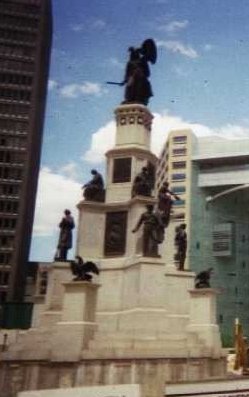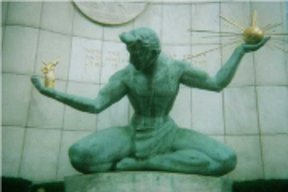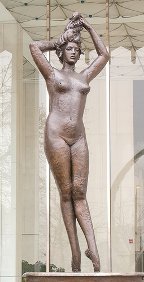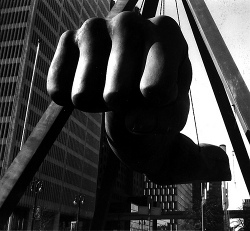
Michigan Soldiers' and Sailors' Monument
Sculptor: Rudolph Rogers Photographer: Elliott Shevin
Generals George Armstrong Customer, Philip H. Sheridan, and Abrose E. Burnside were in attendance at the unveiling of the state's foremost Civil War monument on April 9, 1872. Randolph Rogers, who had created similar Civil War monuments in Ohio and Rhode Island, designed the Soldiers' and Sailors' Monument after Governor Austin Blair established an association for that purpose in 1865. The work was funded through voluntary contributions from citizens.
When Campus Martius Park was dedicated in 2005 at the site where Michigan's soldiers met before joining the Civil war, the monument was rededicated. The time capsule contained in the monument was opened, and the list of Michigan War Dead was updated to reflect all those killed from the Civil War up to April 2005 in Iraq and Afghanistan.
The base is a series of octogonal sections. The lowest are topped by eagles with raised wings that guide the viewer's eye up to the next section topped with four mail figures symbolizing the Navy, Infantry, Cavalry, and Artillery branches of the United States Army. Four female figures, resting above the male statues and representing Victory, History, Emancipation, and Union, were later additions, as are four plaques containing bas-reliefs of the Union leaders Lincoln, Grant, Sherman, and Farragut. Atop the monument, the heroic Amazon figure Michigania, or Victory, brandishes a sword in her right hand and a shield in her left.
The monument was listed on the National Register of Historic Places in 1984. |

The Spirit of Detroit
Sculptor: Marshall Fredericks
Photograph: Elliott Shevin
No work is more closely identified with Detroit than this one by the area's best known sculptor, Marshall Fredericks. Although known as the "Spirit of Detroit," Fredericks never named it; the popular appellation comes from the Biblical verse that runs on the wall behind the statue: "Now the Lord is that Spirit: and where the Spirit of the Lord is, there is liberty." (2 Corinthians 3:17).
This work was dedicated in 1958 to front the new City-County Building (since renamed the Coleman A. Young Municipal Center). The bronze sphere with emanating rays in the Spirit's left hand symbolizes God. The family group in its right hand symbolizes all human relationships. A plaque in front of the sculpture bears the inscription, "Through the spirit of man is manifested in the family, the noblest human relationship."
Standing 26 feet, the Spirit was the largest cast bronze statue since the Renaissance when it was installed.
The "Jolly Green Giant" has occasionally been dressed to celebrate local events. He's shown here in a Detroit Pistons jersey to commemorate that team's 2004 NBA championship, and he sported a tuxedo during a visit by the Three Tenors. |
Pazzo di Danza (Step of the Dance)
Sculptor: Giacomo Manzu
Photograph: Steve Burt
This work, modeled after the artist's wife, was commissioned in 1961 by Detroit architect Minoru Yamasaki for the south entrance of what was then the Michigan Consolidated Gas Company building. The dancer stands 11 feet tall. |

Joe Louis Memorial
Sculptor: Robert Graham Photograph: Derek Van Gieson
Is this what Max Schmeling saw coming at him?
"Making a statue of a fighter would have been a limited image of Joe Louis," said Robert Graham, the sculptor responsible for Detroit's monument to the late heavyweight boxing champ. Instead Graham created a 24-foot bronze arm and fist suspended from pyramidal support beams that stand 24 feet tall.
Not surprisingly, the work became instantly controversial upon its unveiling in October 1987. Some interpreted it as a symb0l of Black power. Others wondered why it lacks a boxing glove. But all agree it symbolizes the raw power of the "Brown Bomber's" fist. |

